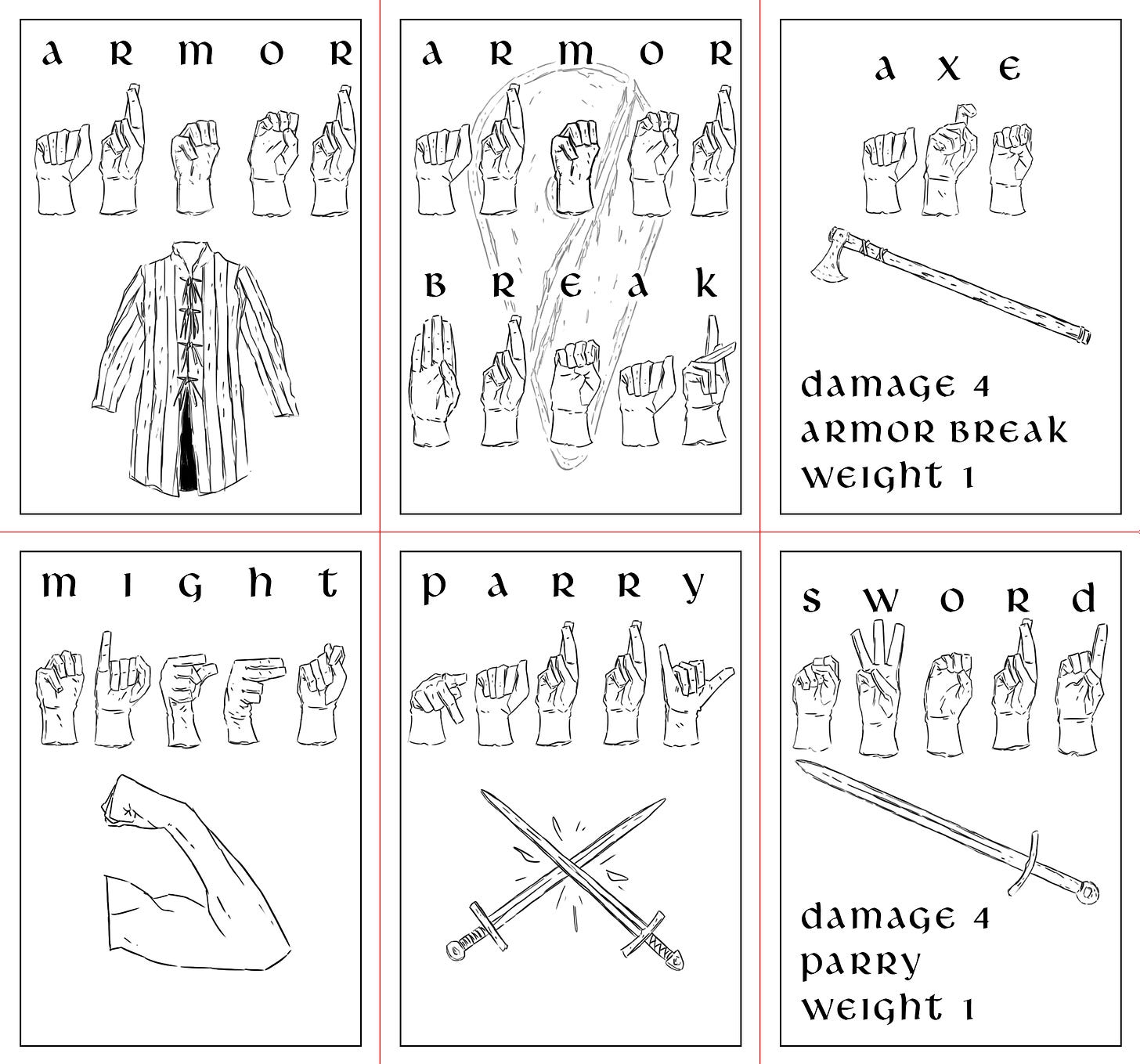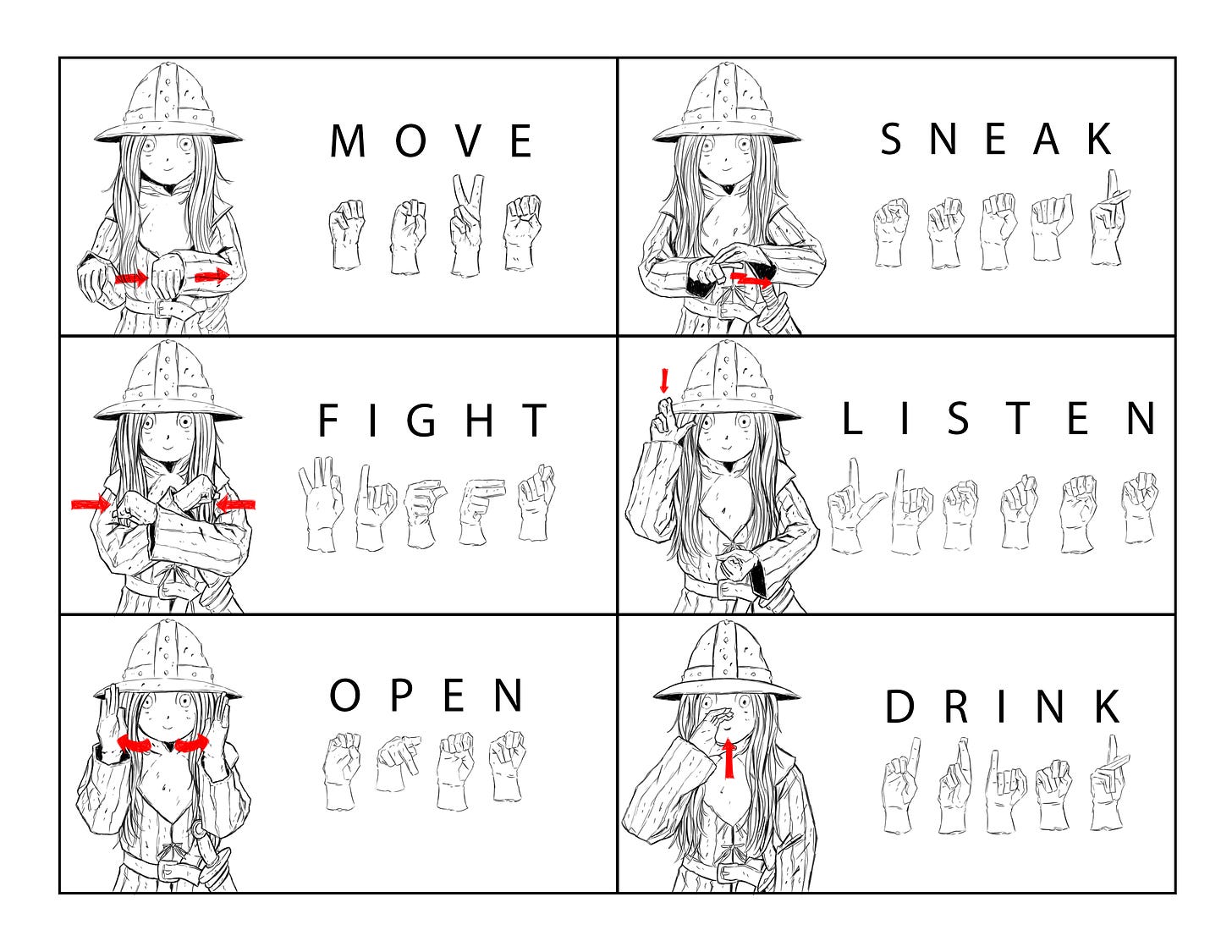An Even Simpler Dungeon Crawl
Years ago my wife and I released a Dice Pool version of Dungeons & Delvers—initially called A Really Simple Dungeon Crawl—a game we designed for our oldest daughter to help her out with math. Plus, at the time, playing the d20 version was too complicated (though as she got older she ultimately read the entire book and turned into a bit of a rules lawyer).
In keeping with tradition our youngest daughter is now also interested in playing, though she got interested at a younger age and, more importantly, was born mostly deaf (and will go completely deaf at some point).
I started making a series of ASL “action cards”, which feature a character doing the sign (essentially her in fighter getup), then it spelled out, and then finger-spelled so as to ideally help her associate the word with the action and also help her learn to read. Here’s one of the sheets to show you what I mean:
I realized later that just one image per sign won’t do. I’ll need at least two to better convey the motions—for example, open should start with both hands in front of your face—but that’s a simple matter and I’ll rotate the images to portrait so they can all go into a proper book when complete.
The other thing I realized is that even a streamlined Dungeons & Delvers with simplified everything is still too complex for a 5-year-old, and she’s only a year and a half into learning sign language to boot, so our goal is to create the simplest game we can, with no dice rolling, period, because it’s going to be a while before we can properly convey to her what the dice are for and what the results even mean.
So here’s what I came up with last night and somewhat refined today, in no particular order:
Each character currently has 10 Wound Points and no ability scores of any kind. Race could feasibly add something but for now you just pick whatever looks the best. The three current Archetypes are warrior, wizard, and thief, because even working with the sign language school it’s difficult to find a sign that conveys rogue or “a guy that gets a lot of skill points”.
With thief it’s a clear, simple sign and it works well enough.
Each archetype does the following:
Warrior Tough 1, Might 1
- Wizard Magic Staff 1, gets 2 Spells
- Thief Sneak Attack +1, Tinkerer, Sneak
And here’s what those terms mean:
- Tough Reduce damage by 1. Refreshes at the start of each round.
- Might Deal +1 Damage with a melee attack. Refreshes at the start of each round.
- Magic Staff Reduces Willpower cost of a Spell by 1, or deal +1 Damage with a Spell. Refreshes at the start of each round.
- Sneak Attack Deal +1 Damage when target is next to an ally.
- Tinkerer Skill. Lets the thief deal with locks and traps.
- Sneak Lets the thief move around without being detected. Used for scouting.
Everything that refreshes at the start of the round will be on a card, and you flip the card over when used, or put it in a discard pile and grab it when the round starts. We want to link as much of the game to visual aids to make it easier for our daughter to understand what is going on.
Here’s what a 1st-level warrior might look like:
Skills
- Search 1
Defense
- Shield 1
- Parry 1
- Armor 3
- Tough 1
- Wound Points 10
Offense
- Might 1
- Arming Sword 3 Damage, Parry 1
And here’s what all that means:
- Search Everyone has this Skill by default. Thieves can probably boost it as a Talent. We’re trying to figure out how it works and I’ll explain that in more detail, at the end.
- Shield You get this by having a shield equipped. Reduces Damage by 1. Flip over when used, refreshes at the start of the round.
- Parry Like shield, but gained by having a sword equipped.
- Armor Also like shield, but gained by wearing armor.
Defense
- Tough 1
- Parry 1
- Shield 1
- Wound Points 5
Offense
- Arming Sword 3 damage, Parry 1
Here, for the fighter’s first hit he can use Might 1 to bump up the damage to 5, which gets reduced to 2 from all of the Skeleton’s Defensive traits, then the second one deals 4 damage, for a total of 6, which is still enough to take it down so we’re still on track in terms of relative monster durability.

All attacks are considered automatic hits. You pick a target, and then whoever controls the target discards a number of Wound cards equal to the Damage value of the attack, though they can reduce this amount using various defensive cards like Armor, Shield, Parry, etc. At 0 you’re unconscious: death would be a rare thing because, again, deaf 5-year old.
Cover and things that would reduce accuracy instead reduce Damage. Things that might improve accuracy increase damage, though in both cases we want to limit it largely to 1 or 2 points.
Resting takes a Ration and sets Wounds to maximum. No clerics because adventuring clerics don’t make sense. It’s mostly alchemical potions, healing salves, and such.
For the thief, Tinkerer basically let’s him deal with all locks and traps. In order to make it a clear choice, opening a locked door takes a “turn”—even though in real life opening locks is extremely quick and easy (maybe anyone can open locks but thieves do it quickly?)—but makes it so that you can see what’s in the room and get surprise, otherwise you gotta bash the door, which means things on the other side get to act first.
Search is a skill we’re considering as a way to deal with whether or not the characters notice traps or something. The idea is that different things in areas/rooms have a Detect value, and you essentially need to invest Search points in it to find it.
I’m loathe to include storygame elements, but one method would be to give the characters a list of things to search for, ie monsters, traps, or treasure. You could even show them a list with the necessary number of points and let them figure out what they want to find.
For example, a list might be:
Monster 2
Trap 1
Treasure 2
And if you have four characters each with Search 1, then they can find the Monster and Trap, or the Trap and Treasure, or the Monster and Treasure, but not all three because they don’t have enough points.
Or you just ask them what they are specifically looking for, put the points wherever, and tell them what they find based on the totals.
OR you just make a list and then tally up the total Search values for the area/room in general. Here’s a rough, vague example:
Search 2: You find this monster
Search 3: You also find that monster
Search 4: You find some treasure
Search 5: You find all the treasure
Makes more sense I’d say, but then takes all decision making out of the game: players just go in the room and find…whatever, and have no ability to find anything else so have no incentive to even bother trying anything. At least with method one they know what the consequences are, and method two they have an idea of what could go wrong.
So while I prefer method two because it makes the choice matter, method one might be better for a deaf five-year old.
Not sure how to handle Sneak. I don’t want it to just be “monsters can’t detect you”. Maybe it just lets the thief see what’s in the next area over without getting spotted (he scouts it out), so the party can make a decision as to whether they want to deal with it. Or maybe it lets the thief be hidden for a round and do more damage (kind of like the sniper class in Space Marine 2 and its cloak ability). Or both.
Really I just want it to be a compelling choice without being oddly more complex than the wizard. And on that note, here’s what a wizard Spell might look like:
Lightning Bolt 3 Magic; Range 10; 5 damage (Ignores Armor, Stun 1)
A wizard can spends his Action to pick up a Magic card, which is then spent to cast a spell. Some spells require 3 or more Magic, so we couldn’t just say “Lightning Bolt takes 2 Actions”. Plus the Magic Staff lets you grab +1 Magic when you use that Action, so with his staff the wizard can basically cast lightning bolt every round (as long as he remains still).
Ignore Armor means that you act like the target has 0 Armor. It can still be partially soaked by the Tough trait. Stun 1 means that the target also loses an Action during its turn, though it can negate this effect by taking 1 Damage or reducing its next attack by 1 Damage. This is to avoid characters easily stun-locking enemies, especially solitary monsters.
Torches provide light and are good for 10 “turns”, which will be abstracted and include activities such as:
Combat (basically the whole of combat takes a “turn”)
- Looting bodies might also be a turn
- Searching a room/area (for treasure, traps, etc)
- Fixing armor that was broken
- Patching up wounds (requires a healing item or Medicine skill and restores a bit of WP)
- Moving between multiple rooms/areas without stopping to do much of anything
My daughter loves pets so gotta incorporate those, which should be easy. Just give them a monster stat block and call it good.
Leveling up will be stupid easy and just be you picking one new ability. For the warrior these would be something like:
- +2 Wound Points
- +1 Tough
- Shield Block: Once per round flip over shield card to completely negate attack (doesn’t work on attacks that Ignore Armor or Ignore Shields)
- +1 Might
- Learn Medicine 1
- +1 Search
- Ramming Speed: When charging deal +1 Damage.













Leave a Comment